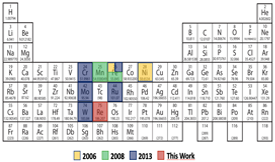
A force field for MD simulations on rhenium organometallic compounds developed from enthalpy of sublimation and X-ray diffraction measurements
C.E.S. Bernardes, M.T. Donato, M.F.M. Piedade, H.P. Diogo, J.N. Canongia Lopes, M.E. Minas da Piedade
J. Chem. Thermodyn. 2019, 133, 60-69.
Abstract
The standard (pº = 0.1 MPa) molar enthalpies of sublimation, at 298.15 K, of methyltrioxorhenium(VII), ΔsubHom[CH3ReO3] = 70.2±0.4 kJ.mol-1, and dirhenium decacarbonyl, ΔsubHom[Re2(CO)10] = 97.4±0.9 kJ.mol-1, corresponding to well characterized crystalline phases, were determined by Calvet microcalorimetry. These results, along with structural data obtained in this work by single crystal X-ray diffraction for [CH3ReO3], or previously reported for [Re2(CO)10], tetramethylammonium perrhenate(VII), [N1111][ReO4], and hexamethylrhenium(VI), Re(CH3)6, were used to extend our previously developed all-atom force field for organometallic compounds, to rhenium species. The new parametrization was able to reproduce the enthalpies of sublimation and unit cell parameters of the test set with maximum absolute deviations of 3.3 kJmol-1 and < 3.8%, respectively. The transferability of the interaction (ε) and atomic diameter (σ) parameters of the Lennard-Jones (12-6) potential function, previously observed for first and second-row transition metals, was also found to be valid for rhenium and tungsten (third-row metals).
Return Previous Next